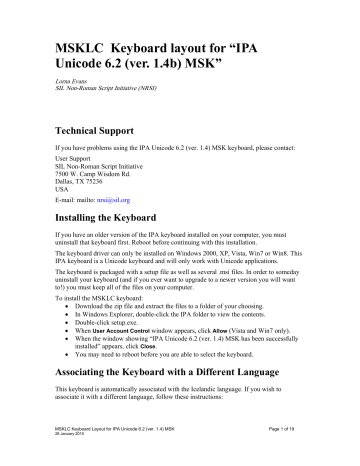

With the grave accent denotes the pronunciation / / (as e in bet, that is, the open e).
#E WITH TILDE IN IPA CODE#
To do this, press and hold down the Alt key whilst pressing the A Tilde Alt code (i.e., 0195 for Uppercase or 0227 for lowercase) using the numeric keypad.
#E WITH TILDE IN IPA HOW TO#
ALT Codes for Foreign Language Letters with AccentsĮ umlaut : Alt 0235: : e umlaut : Alt 0204: : I grave : Alt 0236: : i grave : Alt 0205: : I acute : Alt 0237: : i acute : Alt 0206: : I circumflex : Alt 0238: : i circumflex : Alt 0207: : I umlaut : Alt 0239: : i umlaut : Alt 165: : N tilde: Alt 164: : n tilde: Alt 0210: : O grave: Alt 0242: : o grave: Alt 0211: : O acute : Alt 0243: : o acute : Alt 0212: : O circumflex : Alt 0244: : o circumflex : Alt 0213: : O tilde | How to Type A with Tilde Accent on KeyboardĮven though this Symbol has no dedicated key on the keyboard, you can still type it on the keyboard with the Alt code method. Languages may use to indicate a certain sound (), stress pattern (), length or tone (), as well as to write loanwords or distinguish identical-sounding words (). , (e-acute) is a letter of the Latin alphabet.In English, it is used for loanwords (such as French rsum), romanization (Japanese Pokmon) or occasionally as a pronunciation aid in poetry. Here are the normal rules with examples of words that follow them as well as words that need accents because they break the rules. The acute accent indicates that the normal rules of word stress are being overridden. The Spanish acute accent* (,, ,, ) serves two purposes: 1. Acute Accent:, ,, , - Lawless Spanish Pronunciation Switch over to the Insert tab, and then click the Advanced Symbol or Symbol button. If you only need to insert accented characters occasionally, its easy enough to pop open Microsoft Words Symbol window and hunt for the letter you need. Insert Accented Letters with Words Insert Function. Capital Letter E With Circumflex And Tilde: Alt + 7877: 1EC5 + Alt + X: : Small Letter E With Circumflex And Tilde: Alt + 7878: 1EC6 + Alt + X: : Capital Letter E With Circumflex And Dot Below: Alt + 7879: 1EC7 + Alt + X: : Small Letter E With Circumflex And Dot Below: Alt + 7888: 1ED0 + Alt + X: : Capital Letter O With Circumflex And Acute: Alt + 7889 How to Type Accent Marks Over Letters in Microsoft Word
#E WITH TILDE IN IPA WINDOWS#
Keyboard Shortcuts for Accent Letters in Windows - WebNots Insert | Symbols | Symbol and look for the Tilde symbol. Web: ˜ or ~ or ~ (web codes arent used in Microsoft Office, weve included them for the sake of completeness.) Word, Excel, PowerPoint and Outlook. These are the important code numbers or values youll need to enter the Tilde or ~ Decimal: 126 Hex: 007E or just 7E. CTRL+SHIFT+&, s Tilde ~ symbol in Word, Excel, PowerPoint and Outlook. CTRL+/, o or O ALT+CTRL+SHIFT+? ALT+CTRL+SHIFT+!. Keyboard shortcuts to add language accent marks in WordĬTRL+SHIFT+~ (TILDE), the letter. E With Tilde In Word Related Search for: E With Tilde In WordĮ with tilde: How to type it on keyboard ( or ) Note how this is closer to the canonical use of this IPA notation in e.g. However, there is plenty of variation within Occitan, and actually the concept of a nasal release or off-glide is actually attested in Provence, hence "to split" can be pronounced as as well as a completely deleted nasal consonant. Having both can result in the sounds being perceived as "semi-nasalised" by French speakers that is certainly what many hear in the accent méridional of French. What is interesting about Occitan is that it has "both": a nasalised vowel can be followed by a nasal stop consonant, which in isolation is typically the velar one: hence for quand (cognate across both French and Occitan). This includes restoration of the nasal stop consonant, and in northern metropolitan French, a slight shift in the vowel back to its cardinal point, viz: on a. Synchronically though, in environments that cause liaison, the vowel is completely denasalised. For example, the French pronoun on has no consonant at all when pronounced in the standard way /ɔ̃/. Diachronically, loss of final /n/ from Vulgar Latin / Old French has led not only to phonetic nasalisation of the vowel, but also to the deletion of the final nasal stop. What semi-nasalisation means in this case has to be put into context with "full" nasalisation in standard French pronunciation. in the most common systematic romanisation of Xiamen and Taiwanese Hokkien Chinese, pe̍h-ōe-jī. But use of superscript "n" for nasalisation is often seen, e.g. Standard IPA certainly would use a tilde over the vowel instead.


 0 kommentar(er)
0 kommentar(er)
